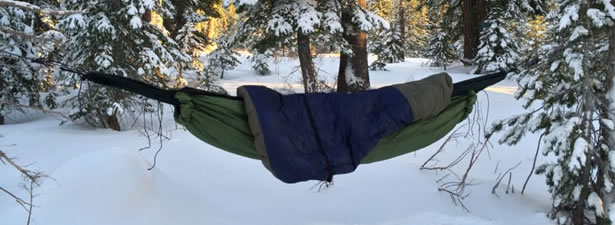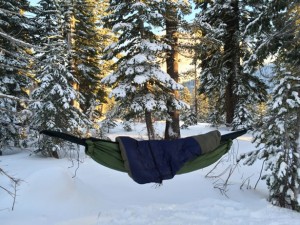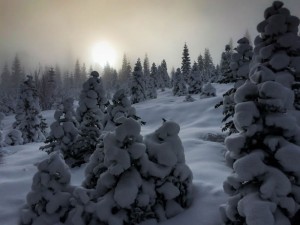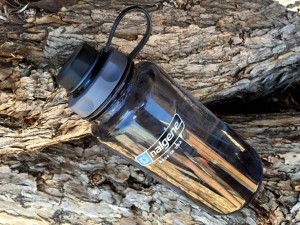7 tips to surviving winter hammocking

When most people think of camping, images of long hours of sunlight and lakeside swim holes are conjured up in their minds. Long days ending with a symphony of insects at sundown followed by a few hours sitting around the campfire before turning in for the night. But for the true outdoor enthusiasts, there’s no reason that nights out in the wild have to end as the seasons change. Winter camping brings significant challenges that differ from summertime, but the rewards can be well worth it. Waking up after a snowfall to a brilliant white winterscape, sipping hot tea to fight off the encroaching cold and getting lucky enough to see the dazzling Aurora Borealis are just a couple of magical experiences you can only find when you brave the winter weather. With the right preparation, winter camping can be both a memorable and pleasant experience. And to top it off, we won’t just be tent camping, we’ll be hammock camping.
1. Make sure you have a proper sleeping bag
The most obvious concern in the winter is the cold. Hammocks without pads or a sleeping bag work during the summer, but even then, when a breeze comes along, you feel it rush through the breathable fabric, cooling you down. The single most important thing to have when camping in the colder months is proper insulation for your hammock. Make sure you research how cold it can be wherever you’re planning on staying and plan accordingly.
Your regular sleeping bag might be fine for most of the year, but there is a reason sleeping bags are usually categorized as 3-season or winter. A winter bag will be heavier with more fill to provide greater insulation. While I normally prefer down insulation in all situations, take the time to carefully consider your options for winter camping. The greatest disadvantage that down has over synthetic fill is that once wet, a down sleeping bag is rendered completely useless (and is often even worse than no insulation at all). Synthetic insulation offers the benefit of resisting moisture from completely negating its insulation properties, though it comes at the cost of being even bulkier and heavier than the already heavy winter sleeping bags. If choose a down sleeping bag, make sure you select one that has been treated to make either the down itself hydrophobic or the sleeping bag shell to have a waterproof layer. Making sure your insulation stays dry is the most important thing when camping in the winter; failure to do so would be disastrous. Learn more about staying dry when hammocking in the rain.
2. Ensure you also have proper insulation underneath you
You can get away with just a hammock and a sleeping bag in the warm nights of summer, but when out in the winter, proper insulation for your backside becomes doubly important. A cheap and popular choice are sleeping pads. There are two common problem when using sleeping pads that you should be aware of. The first is that they have a hard time staying put underneath you as they have a tendency to shift around as you move. This can be resolved by inserting the sleeping pad directly into the sleeping bag, ensuring that it will move with any tossing and turning you might do at night. Secondly, some people find the a sleeping pad does not provide enough insulation to your sides. You can alleviate this by using an extra wide sleeping pad, or modifying it with “wings” (making a cross shaped pad) that extend the width of your pad around your chest allowing you to keep your arms warm. If you’re using a 3/4th quilt or you want to extend your insulation, you can also toss your pack into the hammock for your feet or arms.
 The best choice for bottom insulation is an underquilt. A down underquilt weighs little more than my foam pad and packs down even smaller. Having my insulation under the hammock also makes it more comfortable to sleep – I don’t have to worry about it shifting under me throughout the night. The under quilt also wraps around the entire bottom of the hammock, trapping heat in while blocking the wind from penetrating. The downside of an underquilt is the high cost and the same disadvantages that a down sleeping bag has. It is doubly important that you have a proper rainfly in case the weather goes bad as the underquilt is otherwise completely exposed to the elements. If you’re hammocking on a budget, there are a cheaper alternatives for insulation than an underquilt.
The best choice for bottom insulation is an underquilt. A down underquilt weighs little more than my foam pad and packs down even smaller. Having my insulation under the hammock also makes it more comfortable to sleep – I don’t have to worry about it shifting under me throughout the night. The under quilt also wraps around the entire bottom of the hammock, trapping heat in while blocking the wind from penetrating. The downside of an underquilt is the high cost and the same disadvantages that a down sleeping bag has. It is doubly important that you have a proper rainfly in case the weather goes bad as the underquilt is otherwise completely exposed to the elements. If you’re hammocking on a budget, there are a cheaper alternatives for insulation than an underquilt.
3. Make sure you have good wind protection
One of the wonders of hammock camping are the flexibility in campsite and unobstructed views of mother nature. In the winter though, it may be a wiser and warmer choice to nestle deep within the forest. Instead of being right up along the tree line, with your views of mountains and lakes, find a spot that’s surrounded by trees to have some natural wind protection. Look for other natural barriers such as boulders and hills to help out as well.
 The higher up you hang your hammock, the more windy it gets. In the winter time, keep your hammock low to the ground to give yourself a bit more natural insulation. Make sure your tarp is positioned at a steeper angle than you would have it during the summer to provide more windproofing. Consider a completely enclosed tarp with doors to provide extra protection from any sudden storms or strong gales you may encounter.
The higher up you hang your hammock, the more windy it gets. In the winter time, keep your hammock low to the ground to give yourself a bit more natural insulation. Make sure your tarp is positioned at a steeper angle than you would have it during the summer to provide more windproofing. Consider a completely enclosed tarp with doors to provide extra protection from any sudden storms or strong gales you may encounter.
4. Make sure you aren’t camping below any dead branches
This is a good rule to follow whenever your hammock camping, but extra important in the winter. Dead or loose branches on trees are called widowmakers for good reason, with several fatalities attributed to them each year. In the winter, the accumulation of snow throughout the night and the constant barrage of strong wind can add enough weight to dislodge broken or dead branches and send it careening below. Choose younger trees that do not have huge branches, with most of their limbs still alive so that any that do fall won’t be coming from a dangerous height and will mostly prove to be a small nuisance rather than a deadly accident.
5. Bring a mylar blanket
A mylar blanket (or space blanket) is a thin reflective plastic blanket that is cheap, lightweight and incredibly portable. The reflective properties trap heat generated by your body and reflects it back at you. In the winter, it should be a staple in your survival kit in case of an emergency. You can wrap it around you as a blanket or attach it to the underside of your tarp to provide some extra heat retention for your shelter.
6. Fill up your water bottle with hot water
 The most frustrating thing when camping below freezing, is waking up to a frozen solid water bottle. If you have the gas to spare, this can be easily solved by filling up your Nalgene with hot water and throwing into your sleeping bag as you sleep. This serves a triple function of keeping the water from freezing, warming up cold spots in your hammock and providing you with warm drinking water if you get thirsty. You can put the water bottle in a sock or wrap it in clothes to keep the warmth longer lasting and also prevent the hot water from burning you.
The most frustrating thing when camping below freezing, is waking up to a frozen solid water bottle. If you have the gas to spare, this can be easily solved by filling up your Nalgene with hot water and throwing into your sleeping bag as you sleep. This serves a triple function of keeping the water from freezing, warming up cold spots in your hammock and providing you with warm drinking water if you get thirsty. You can put the water bottle in a sock or wrap it in clothes to keep the warmth longer lasting and also prevent the hot water from burning you.
7. Make sure you take care of “business” before you get in your hammock
Sometimes we can’t help our bodily functions, but try your best take to answer nature’s call right before you settle into your sleeping bag. You don’t want to wake up with the urge to pee (or worse) in the dead cold winter night. At best you’ll scramble out of your warm shelter and lose a lot of the ambient heat you had generated. At worst you’ll be kept awake for hours, not wanting to leave the warmth of the hammock, but also unable to fall asleep without a trip to the bushes. It’s just good practice to make sure empty out your bladder before you get in the hammock at night!
![]()
About the Authors
All content and photos provided courtesy of Wilson Lin and Jeff Zhang of Serac Ultralight Camping Hammocks.
WILSON LIN grew up in the concrete jungles of NYC. After venturing out to the west coast, his thirst for the outdoors could not be satiated. He spends most of his weekends in the Sierra Nevada’s hanging out in his hammock.
JEFF ZHANG fell in love with the outdoors as a toddler living in Vancouver. He strives to share his love of exploration and wilderness with the world, taking friends and strangers alike on his adventures through desolate deserts to high alpine lakes.
![]() Serac was founded with the dream of sharing a convenient, affordable, and tree friendly way of exploring the natural world. By providing a simple method of shelter, we aim to spread our passion for the outdoors to seasoned travelers and tentative newcomers alike.
Serac was founded with the dream of sharing a convenient, affordable, and tree friendly way of exploring the natural world. By providing a simple method of shelter, we aim to spread our passion for the outdoors to seasoned travelers and tentative newcomers alike.
--